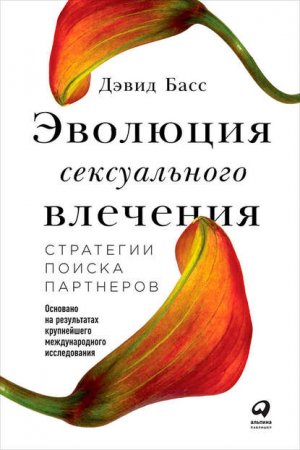Эволюция сексуального влечения: Стратегии поиска партнеров Басс Дэвид

Safilios-Rothschild, C. (1969). Attitudes of Greek spouses toward marital infidelity. In G. Neubeck (Ed.), Extramarital relations, 78–79. Englewood Cliffs, NJ: Prentice Hall.
Sagarin, B. J., Martin, A. L., Coutinho, S. A., Edlund, J. E., Patel, L., Skowronski, J. J., amp; Zengel, B. (2012). Sex differences in jealousy: A meta-analytic examination. Evolution and Human Behavior, 33(6), 595–614.
Saghir, M., amp; Robins, E. (1973). Male and female homosexuality. Baltimore: Williams and Wilkins.
Saletore, R. N. (1974). Sex life under Indian rulers. Delhi: Hind Pocket Books.
–. (1978). Sex in Indian harem life. New Delhi: Orient Paperbacks.
Scelza, B. A. (2014). Jealousy in a small-scale, natural fertility population: The roles of paternity, investment, and love in jealous response. Evolution and Human Behavior, 35(2), 103–108.
Schapera, I. (1940). Married life in an African tribe. London: Faber amp; Faber.
Schmitt, D. P. (2001). Desire for sexual variety and mate poaching experiences across multiple languages and cultures. Paper presented at the annual meeting of the Human Behavior and Evolution Society, London (June).
–. (2003). Universal sex differences in the desire for sexual variety: Tests from 52 nations, 6 continents, and 13 islands. Journal of Personality and Social Psychology, 85(1), 85-104.
–. (2016). Fundamentals of human mating strategies. In D. M. Buss (Ed.), The evolutionary psychology handbook, 2nd ed., 294–316. New York: Wiley.
Schmitt, D. P., amp; Buss, D. M. (1996). Strategic self-promotion and competitor derogation: Sex and context effects on the perceived effectiveness of mate attraction tactics. Journal of Personality and Social Psychology, 70(6), 1185–1204.
–. (2001). Human mate poaching: Tactics and temptations for infiltrating existing mateships. Journal of Personality and Social Psychology, 80, 894–917.
Schneider, H. K. (1964). A model of African indigenous economy and society. Comparative Studies in Society and History, 7, 37–55.
Secord, P. F. (1982). The origin and maintenance of social roles: The case of sex roles. In W. Ickes amp; E. S. Knowles (Eds.), Personality, roles, and social behavior, 33–53. New York: Springer.
Seiler, M. (1976). Monogamy is "unnatural," man with 9 wives says. Los Angeles Times, February 9, pt. 2, p. 1.
Semmelroth, J., amp; Buss, D. M. (unpublished). Studies on conflict between the sexes. Unpublished data, Department of Psychology, University of Michigan, Ann Arbor, Michigan.
Seyfarth, R. M. (1976). Social relationships among adult female baboons. Animal Behavior, 24, 917–938.
Shanley, D. P., Sear, R., Mace, R., amp; Kirkwood, T. B. (2007). Testing evolutionary theories of menopause. Proceedings of the Royal Society of London B: Biological Sciences, 274(1628), 2943–2949.
Shettel-Neuber, J., Bryson, J. B., amp; Young, C. E. (1978). Physical attractiveness of the "other person" and jealousy. Personality and Social Psychology Bulletin, 4, 612–615.
Short, R. V. (1979). Sexual selection and its component parts, somatic and genital selection, as illustrated by man and great apes. Advances in the Study of Behavior, 9, 131–158.
Shostak, M. (1981). Nisa: The life and words of a! Kung woman. Cambridge, MA: Harvard University Press.
Sigusch, V., amp; Schmidt, G. (1971). Lower-class sexuality: Some emotional and social aspects in West German males and females. Archives of Sexual Behavior, 1, 29–44.
Singh, D. (1993a). Adaptive significance of waist-to-hip ratio and female physical attractiveness. Journal of Personality and Social Psychology, 65, 293–307.
–. (1993b). Body shape and female attractiveness: Critical role of waist-to-hip ratio. Human Nature, 4, 297–321.
–. (1994). Is thin really beautiful and good? Relationship between waist-to-hip ratio and female attractiveness. Personality and Individual Differences, 16, 123–132.
Singh, D., Vidaurri, M., Zambarano, R. J., amp; Dabbs, J. M. (1999). Lesbian erotic role identification: Behavioral, morphological, and hormonal correlates. Journal of Personality and Social Psychology, 76(6), 1035–1049.
Small, M. (1992). The evolution of female sexuality and mate selection in humans. Human Nature, 3, 133–156.
Smith, R. L. (1984). Human sperm competition. In R. L. Smith (Ed.), Sperm competition and the evolution of mating systems, 601–659. New York: Academic Press.
Smuts, B. B. (1985). Sex and friendship in baboons. New York: Aldine de Gruyter.
–. (1987). Sexual competition and mate choice. In B. B. Smuts, D. L. Cheney, R. M. Seyfarth, R. W. Wrangham, amp; T. T. Struhsaker (Eds.), Primate societies, 385–399. Chicago: University of Chicago Press.
–. (1992). Male aggression against women: An evolutionary perspective. Human Nature, 3, 1-44.
–. (1995). The origins of patriarchy: An evolutionary perspective. In A. Zagarell (Ed.), Origins of gender inequality. Kalamazoo, MI: New Issues Press.
Smuts, B. B., amp; Smuts, R. W. (1993. Male aggression against female primates: Evidence and theoretical implications. In P. J. B. Slater, J. S. Rosenblatt, M. Milinski, amp; C. T. Snowden (Eds.), Advances in the study of behavior. New York: Academic Press.
Souza, A. L., Conroy-Beam, D., amp; Buss, D. M. (2016). Mate preferences in Brazil: Evolved desires and cultural evolution over three decades. Personality and Individual Differences, 95, 45–49.
Spanier, G. B., amp; Margolis, R. L. (1983). Marital separation and extramarital sexual behavior. Journal of Sex Research, 19, 23–48.
Sprecher, S., Aron, A., Hatfield, E., Cortese, A., Potapova, E., amp; Levitskaya, A. (1992). Love: American style, Russian style, and Japanese style. Paper presented at the Sixth International Conference on Personal Relationships, Orono, Maine.
Stern, B. (1933). The scented garden: Anthropology of the sex life in the levant. New York: American Ethnological Press.
Sternberg, R. J. (1988). The triangle of love. New York: Basic Books.
Strassman, B. I. (1981). Sexual selection, parental care, and concealed ovulation in humans. Ethology and Sociobiology, 2, 31–40.
Stroebe, W. (1977). Self-esteem and interpersonal attraction. In S. W. Duck (Ed.), Theory and practice in interpersonal attraction, 79-104. London: Academic Press.
Studd, M. V., amp; Gattiker, U. E. (1991). The evolutionary psychology of sexual harassment in organizations. Ethology and Sociobiology, 12, 249–290.
–. (in preparation). Evolutionary psychology of sexual harassment: Effect of initiator profile and social context on response of recipients of sexual advances in the workplace. Faculty of Management, University of Lethbridge, Alberta.
Surbey, M. K., amp; Conohan, C. D. (2000). Willingness to engage in casual sex. Human Nature, 11(4), 367–386.
Symons, D. (1979). The evolution of human sexuality. New York: Oxford University Press.
–. (1987). If we're all Darwinians, what's the fuss about? In C. B. Crawford, M. F. Smith, and D. L. Krebs (Eds.), Sociobiology and psychology: Ideas, issues, and applications, 121–146. Hillsdale, NJ: Erlbaum.
–. (1989). The psychology of human mate preferences. Behavioral and Brain Sciences, 12, 34–35.
–. (1992). What do men want. Behavioral and Brain Sciences, 15(1), 113–114.
Takahashi, H., Matsuura, M., Yahata, N., Koeda, M., Suhara, T., amp; Okubo, Y. (2006). Men and women show distinct brain activations during iry of sexual and emotional infidelity. Neuro-Image, 32(3), 1299–1307.
Tanner, R. E. S. (1970). Homicide in Uganda, 1964: Crime in East Africa. Uppsala, Sweden: Scandinavian Institute of African Studies.
Taylor, P. A., amp; Glenn, N. D. (1976). The utility of education and attractiveness for females' status attainment through marriage. American Sociological Review, 41, 484–498.
Teisman, M. W., amp; Mosher, D. L. (1978). Jealous conflict in dating couples. Psychological Reports, 42, 1211–1216.
Terman, L. M. (1938). Psychological factors in marital happiness. New York: McGraw-Hill.
Terpstra, D. E., amp; Cook, S. E. (1985). Complainant characteristics and reported behaviors and consequences associated with formal sexual harassment charges. Personnel Psychology, 38, 559–574.
Thakerar, J. N., amp; Iwawaki, S. (1979). Cross-cultural comparisons of interpersonal attraction of females toward males. Journal of Social Psychology, 108, 121–122.
Thibeau, J. W., amp; Kelly, H. H. (1986). The social psychology of groups. 2nd ed. New Brunswick, NJ: Transaction Books.
Thiessen, D., Young, R. K., amp; Burroughs, R. (1993). Lonely hearts advertisements reflect sexually dimorphic mating strategies. Ethology and Sociobiology, 14, 209–229.
Thompson, A. P. (1983). Extramarital sex: A review of the research literature. Journal of Sex Research, 19, 1-22.
–. (1984). Emotional and sexual components of extramarital relations. Journal of Marriage and the Family, 46, 35–42.
Thornhill, N. W. (1992). Female short-term sexual strategies: The self-esteem hypothesis. Paper presented at the meeting of the Human Behavior and Evolution Society, Albuquerque, New Mexico (August).
Thornhill, N. W., amp; Thornhill, R. (1990a). An evolutionary analysis of psychological pain following rape: 1. The effects of victim's age and marital status. Ethology and Sociobiology, 11, 155–176.
–. (1990b). An evolutionary analysis of psychological pain following rape: 2. The effects of stranger, friend, and family-member offenders. Ethology and Sociobiology, 11, 177–193.
Thornhill, R. (1980a). Mate choice in Hylobittacus apicalis (Insecta: Mecoptera) and its relation to some models of female choice. Evolution, 34, 519–538.
–. (1980b). Rape in Panorpa scorpionflies and a general rape hypothesis. Animal Behavior, 28, 52–59.
Thornhill, R., amp; Alcock, J. (1983). The evolution of insect mating systems. Cambridge, MA: Harvard University Press.
Thornhill, R., amp; Gangestad, S. W. (2008). The evolutionary biology of human female sexuality. New York: Oxford University Press.
Thornhill, R., amp; Palmer, C. (2000). A natural history of rape: Biological bases of sexual coercion. Cambridge, MA: MIT Press.
Thornhill, R., amp; Thornhill, N. (1983). Human rape: An evolutionary analysis. Ethology and Sociobiology, 4, 63–99.
–. (1990a). An evolutionary analysis of psychological pain following rape: I. The effects of victim's age and marital status. Ethology and Sociobiology, 11(3), 155–176.
–. (1990b). An evolutionary analysis of psychological pain following rape: II. The effects of stranger, friend, and family-member offenders. Ethology and Sociobiology, 11(3), 177–193.
–. (1992). The evolutionary psychology of men's coercive sexuality. Behavioral and Brain Sciences, 15, 363–421.
Todosijevi, B., Ljubinkovi, S., amp; Arani, A. (2003). Mate selection criteria: A trait desirability assessment study of sex differences in Serbia. Evolutionary Psychology, 1(1), 116–126.
Tooby, J., amp; Cosmides, L. (1989a). The innate versus the manifest: How universal does universal have to be? Behavioral and Brain Sciences, 12, 36–37.
–. (1989b). Evolutionary psychology and the generation of culture: 1. Theoretical considerations. Ethology and Sociobiology, 10, 29–49.
Tooby, J., amp; DeVore, I. (1987). The reconstruction of hominid behavioral evolution through strategic modeling. In W. G. Kinzey (Ed.), The evolution of human behavior: Primate models, 183–237. New York: State University of New York Press.
Tooke, J., amp; Camire, L. (1991). Patterns of deception in intersexual and intrasexual mating strategies. Ethology and Sociobiology, 12, 345–364.
Townsend, J. M. (1989). Mate selection criteria: A pilot study. Ethology and Sociobiology, 10, 241–253.
Townsend, J. M., amp; Levy, G. D. (1990). Effects of potential partners' physical attractiveness and socioeconomic status on sexuality and partner selection. Archives of Sexual Behavior, 371, 149–164.
Trinkaus, E., amp; Zimmerman, M. R. (1982). Trauma among the Shanidar Neanderthals. American Journal of Physical Anthropology, 57, 61–76.
Tripp, C. A. (1975). The homosexual matrix. New York: Signet.
Trivers, R. (1972). Parental investment and sexual selection. In B. Campbell (Ed.), Sexual selection and the descent of man, 136–179. New York: Aldine de Gruyter.
–. (1985). Social evolution. Menlo Park, CA: Benjamin/Cummings.
Udry, J. R. (1980). Changes in the frequency of marital intercourse from panel data. Archives of Sexual Behavior, 9, 319–325.
Udry, J. R., amp; Eckland, B. K. (1984). Benefits of being attractive: Differential payoffs for men and women. Psychological Reports, 54, 47–56.
Utian, W. H. (1980). Menopause in modern perspective: A guide to clinical practice. New York: Appleton-Century-Crofts.
Vandenberg, S. (1972). Assortative mating, or who marries whom? Behavior Genetics, 2, 127–158.
Van Gulik, R. H. (1974). Sexual life in ancient China. London: E. J. Brill.
Voland, E., amp; Engel C. (1990). Female choice in humans: A conditional mate selection strategy of the Krummerhrn women (Germany 1720–1874). Ethology, 84, 144–154.
Wade, T. J., amp; Slemp, J. (2015). How to flirt best: The perceived effectiveness of flirtation techniques. Interpersona, 9(1), 32–43.
Waynforth, D., Hurtado, A. M., amp; Hill, K. (1998). Environmentally contingent reproductive strategies in Mayan and Ache males. Evolution and Human Behavior, 19(6), 369–385.
Weisfeld, G. E., Russell, R. J. H., Weisfeld, C. C., amp; Wells, P. A. (1992). Correlates of satisfaction in British marriages. Ethology and Sociobiology, 13, 125–145.
Weiss, D. L., amp; Slosnerick, M. (1981). Attitudes toward sexual and nonsexual extramarital involvements among a sample of college students. Journal of Marriage and the Family, 43, 349–358.
Weiss, D. S. (1975). Marital separation. New York: Basic Books. Welham, C. V. J. (1990). Incest: An evolutionary model. Ethology and Sociobiology, 11, 97-111.
White, G. L. (1980). Inducing jealousy: A power perspective. Personality and Social Psychology Bulletin, 6, 222–227.
–. (1981). Some correlates of romantic jealousy. Journal of Personality, 49, 129–147.
Whitehurst, R. N. (1971). Violence potential in extramarital sexual responses. Journal of Marriage and the Family, 33, 683–691.
Whyte, M. K. (1990). Changes in mate choice in Chengdu. In D. Davis amp; E. Vogel (Eds.), China on the eve of Tiananmen.
Cambridge, MA: Harvard University Press.
Wiederman, M. W. (1993). Evolved gender differences in mate preferences: Evidence from personal advertisements. Ethology and Sociobiology, 14, 331–351.
Wiederman, M. W., amp; Allgeier, E. R. (1992). Gender differences in mate selection criteria: Sociobiological or socioeconomic explanation? Ethology and Sociobiology, 13, 115–124.
Willerman, L. (1979). The psychology of individual and group differences. San Francisco: Freeman.
Williams, G. C. (1957). Pleiotropy, natural selection, and the evolution of senescence. Evolution, 11, 398–411.
–. (1975). Sex and evolution. Princeton, NJ: Princeton University Press.
Wilson, E. O. (1975). Sociobiology: The new synthesis. Cambridge, MA: Harvard University Press.
–. (1978). On human nature. Cambridge, MA: Harvard University Press.
Wilson, G. D. (1987). Male-female differences in sexual activity, enjoyment, and fantasies. Personality and Individual Differences, 8, 125–126.
Wilson, M. (1989). Conflict and homicide in evolutionary perspective. In R. Bell amp; N. Bell (Eds.), Sociobiology and the social sciences, 45–62. Lubbock: Texas Tech University Press.
Wilson, M., amp; Daly, M. (1985). Competitiveness, risk taking, and violence: The young male syndrome. Ethology and Sociobiology, 6, 59–73.
–. (1992). The man who mistook his wife for a chattel. In J. Barkow, L. Cosmides, amp; J. Tooby (Eds.), The adapted mind: Evolutionary psychology and the generation of culture, 289–322. New York: Oxford University Press.
Wilson, M., amp; Mesnick, S. L. (1997). An empirical test of the bodyguard hypothesis. In P. A. Gowaty (Ed.), Feminism and evolutionary biology: Boundaries, intersections, and frontiers. New York: Chapman amp; Hall.
Wolf, M., Musch, J., Enczmann, J., amp; Fischer, J. (2012). Estimating the prevalence of nonpaternity in Germany. Human Nature, 23(2), 208–217.
Wolf, N. (1991). The beauty myth. New York: Morrow.
Yosef, R. (1991). Females seek males with ready cache. Natural History, June, 37.
Young, R. R., amp; Thiessen, D. (1992). The Texas rape scale. Ethology and Sociobiology, 13, 19–33.
Zahavi, A. (1975). Mate selection — a selection for a handicap. Journal of Theoretical Biology, 53(1), 205–214.
–. (1977). The testing of a bond. Animal Behavior, 25, 246–247.
Об авторе
Дэвид Басс — профессор психологии Техасского университета в Остине, автор девяти книг, в том числе «Зачем женщины занимаются сексом» (Why Women Have Sex), «Убийца по соседству» (The Murderer Next Door) и «Опасная страсть» (The Dangerous Passion), а также учебника «Эволюционная психология» (Evolutionary Psychology), на настоящий момент выдержавшего пять изданий. Живет в Остине, штат Техас.






